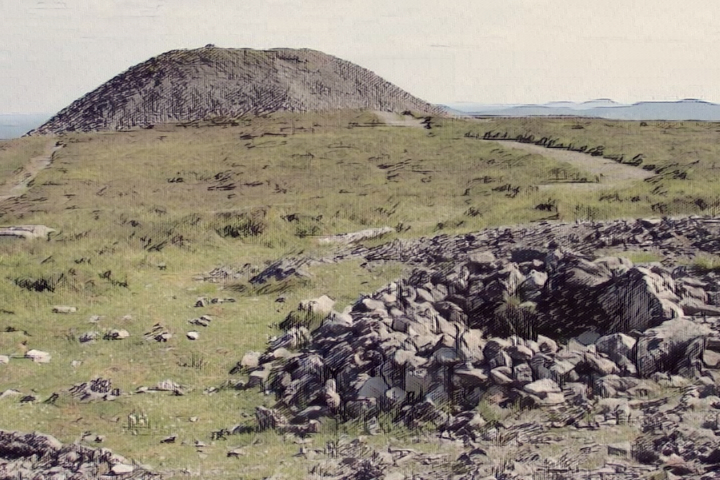Knocknarea is a large hill located west of Sligo town in County Sligo, Ireland. It stands at a height of 327 metres and is visually striking due to its steep limestone cliffs and its location on the Cúil Irra peninsula overlooking the Atlantic coast. At the summit of Knocknarea is one of Ireland’s largest cairns, known as Queen Maeve’s Cairn, which is believed to contain a Neolithic passage tomb.
The name of the hill, Knocknarea, is an anglicization of an Irish name. “Knock” means hill, but the etymology of the rest of the name is disputed. The Placenames Database of Ireland gives the Irish name as Cnoc na Riabh (meaning “hill of the stripes”), but other interpretations have been suggested such as Cnoc na Riaghadh (“hill of the executions”), Cnoc na Riogha (“hill of the kings”) and Cnoc na Ré (“hill of the moon”).
Queen Maeve’s cairn is a large and impressive neolithic monument located in the west of Ireland, in County Sligo. The cairn is part of the Irish passage-grave culture, which arrived in Sligo from Brittany around 4,150 BC. The cairn is situated on the flat top of Knocknarea, at an altitude of 327 meters above sea level, and is the westernmost portion of the complex of neolithic monuments in the area. The cairn is sixty meters in diameter, ten meters high, and is estimated to contain 30,000 tons of stone. The cairn is highly visible, and is the focus of many of the other monuments scattered across the neolithic landscape of County Sligo and several adjoining areas.

There is a wide panoramic view from the top of Queen Maeve’s cairn, and the mountain is visible from many other sites such as Shreeloga Hill, Shee Lugh, and Sheemor. The cairn is probably one of the best preserved monuments of its kind remaining in Ireland, and gives a fair idea of the original shape and form of this type of monument. However, the monument has suffered greatly from the excesses of modern tourism, and is covered with scars caused by people climbing on it. Visitors are encouraged to respect the monument and not climb on it.
The stone used to build the cairn was quarried nearby, and the cairn may have been covered with chunks of white quartz crystal. Swedish archaeologist Dr. Stefan Bergh has surveyed the monuments in the area and has noted several interesting features, such as a low platform beneath the cairn, a set of circular settings around the base of the cairn, and similar sub-cairn platforms at other nearby sites. He published his research in the 1995 book “Landscape of the Monuments”.
